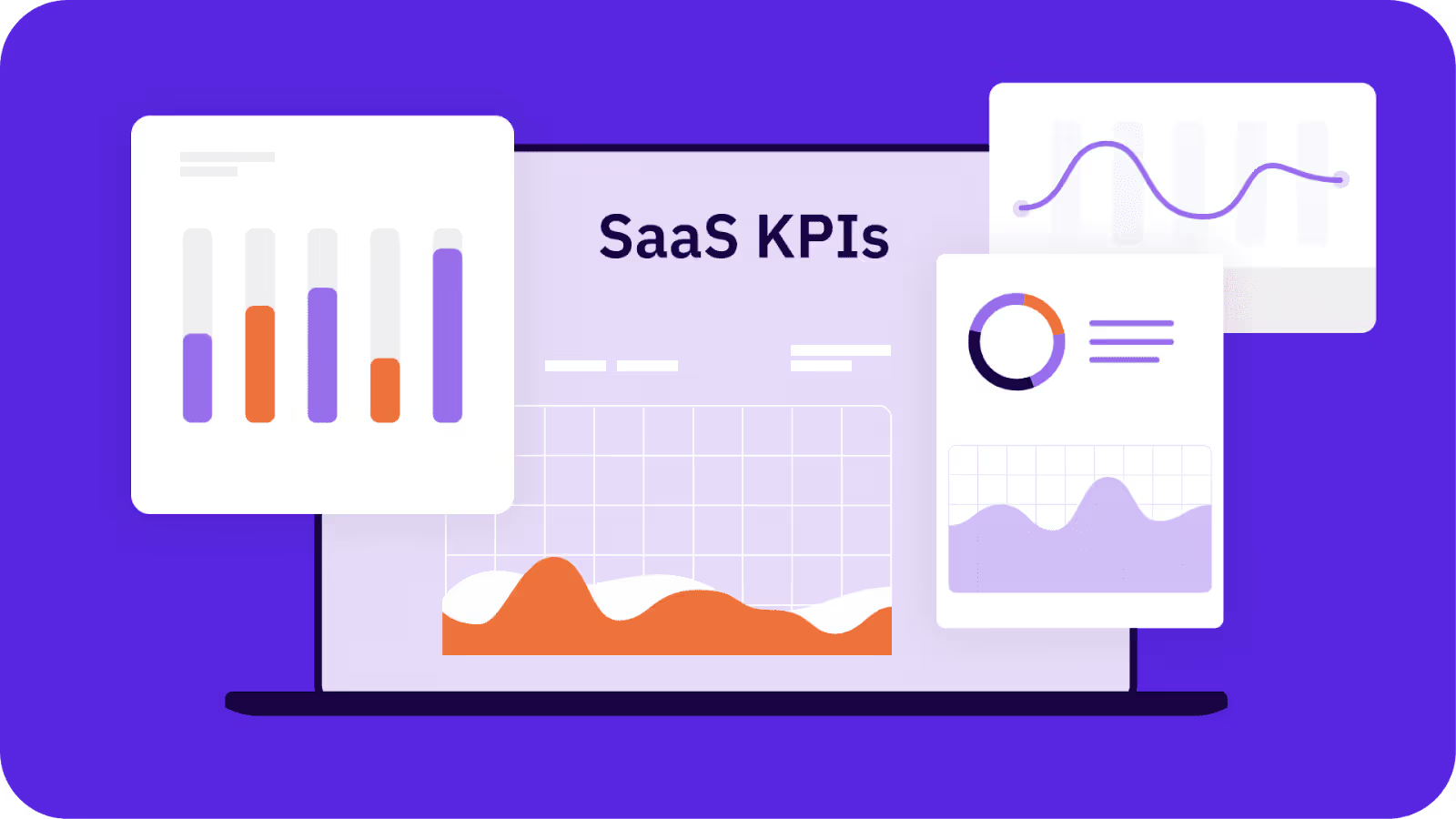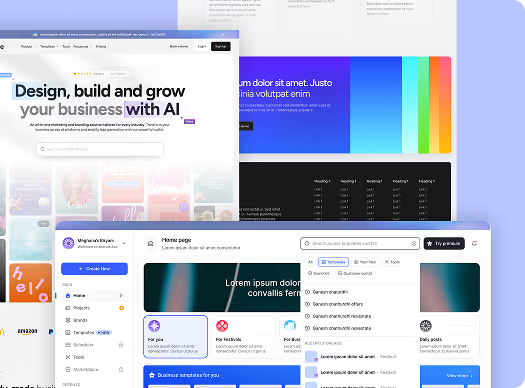10 SaaS Marketing Metrics And KPIs For Growing Your Business

Regardless of the business context, you cannot improve what you don't measure. From this point of view, you need to know the essential SaaS performance metrics that determine your business's survival, growth, and profitability to have the opportunity to improve on them.
Given the fact above, SaaS ROI is dependent on streamlined tracking and progressive improvement of the most critical metrics that matter. Understanding these metrics and how they relate to each other will help you work on the levers that move the needle.
While every SaaS business uses the same business model, the challenges along the path of sustainable growth are rarely the same.
When we talk to some founders, CMOs, and marketers of small and medium-sized SaaS businesses, everyone seems to be struggling with one growth bottleneck. But the surprising thing is that a lack of resources or a lean budget never limits everyone's business growth.
From the operational point of view, there might be lots of things you can do to grow your SaaS business without spending any additional money.
And that's why it's important to understand the essential SaaS business performance metrics and KPIs shared in this post.
SaaS Metrics vs SaaS KPIs

SaaS metrics and SaaS Key Performance Indicators (KPIs) serve distinct purposes in evaluating the performance of a Software as a Service business. SaaS metrics generally encompass a broad range of quantitative measurements, including revenue, customer acquisition cost, and churn rate, providing a comprehensive view of business operations.
On the other hand, SaaS KPIs are specific, strategic indicators that directly align with the company's key objectives and goals, such as customer lifetime value or Monthly Recurring Revenue (MRR).
While SaaS metrics offer a holistic overview of business health, KPIs focus on critical areas for achieving targeted outcomes, guiding decision-making for sustained growth and success in the competitive SaaS landscape.
How Tracking SaaS Metrics That Matter Can Help Grow Your Business

Based on our experience working with SaaS businesses in different niches, growth stages, and their marketing teams, we have shared some pointers on leveraging these metrics to achieve sustainable growth. You'll find other relevant pointers under each core metric discussed in this post.
Operational Insights: Tracking SaaS business metrics like Monthly Recurring Revenue (MRR), customer acquisition cost, and churn rate provides operational insights, enabling data-driven decision-making and optimization of business processes for increased efficiency.
Revenue Optimization: By closely monitoring financial metrics, SaaS companies can identify opportunities to enhance revenue streams, upsell to existing customers, and strategically price their offerings.
Marketing Effectiveness: Marketing KPIs, such as conversion rates, customer acquisition metrics, and customer lifetime value, offer a focused assessment of the effectiveness of marketing strategies, allowing businesses to refine campaigns and allocate resources efficiently.
Customer Retention: Metrics like churn rate help understand customer attrition, enabling proactive measures to improve customer satisfaction, enhance product features, and boost customer retention.
Data Drive Decision-Making: The combination of SaaS metrics and marketing KPIs empowers SaaS businesses to make strategic decisions that align with their growth objectives, ensuring a competitive edge in the dynamic SaaS landscape.
Essential SaaS Marketing KPIs To Track In 2024

#1: Organic vs paid traffic
In SaaS marketing, tracking organic and paid traffic metrics is essential for evaluating the effectiveness of customer acquisition channels. Marketers leverage these metrics to identify high-performing channels, optimize SEO strategies for organic traffic, assess the ROI of paid campaigns, and maintain a balanced approach for sustained growth.
By understanding which channels drive the most valuable users and refining strategies accordingly, SaaS businesses can make informed decisions to enhance their online presence and drive successful customer acquisition.
#2: Customer acquisition cost
Customer Acquisition Cost (CAC) is a vital SaaS business metric measuring the average cost of acquiring a new customer. It is calculated by dividing the total expenses associated with acquiring customers (such as marketing, advertising, and sales costs) by the number of new customers gained within a specific period. For example, if a SaaS company spends $50,000 on marketing and acquires 500 new customers monthly, the CAC would be $100.
CAC is closely linked to SaaS Return on Investment (ROI), as it helps assess the efficiency and profitability of customer acquisition efforts.
A lower CAC indicates a more cost-effective acquisition strategy, allowing SaaS businesses to maximize their ROI and allocate resources strategically for sustainable growth.
#3: Customer lifetime value

Customer Lifetime Value (CLV or LTV) is a critical SaaS business metric that estimates the total revenue a company expects from customers throughout their entire relationship.
To calculate CLV, multiply the average revenue generated per customer per month by the average customer lifespan in months. For instance, if a SaaS company earns $100 per month from a customer with an average lifespan of 24 months, the CLV would be $2,400. CLV is closely tied to SaaS Return on Investment (ROI) as it helps businesses assess the long-term Value of acquired customers.
A higher CLV implies that the investment in developing and retaining customers is profitable, contributing positively to the overall ROI and guiding strategic decisions for sustained business growth.
#4: Monthly active users
Monthly Active Users (MAU) is a crucial SaaS metric measuring the number of unique individuals actively engaging with a software or service within a given month. Increasing MAU is essential for SaaS businesses, indicating a growing user base and higher user engagement.
To boost monthly active users, SaaS companies can focus on user retention strategies, enhance product features based on user feedback, implement targeted marketing campaigns to attract new users and optimize user onboarding processes to encourage regular usage. Additionally, providing value-driven content, personalized experiences, and ongoing customer support can contribute to a positive user experience, fostering increased MAU and overall business success.
#5: Monthly recurring revenue
Monthly Recurring Revenue (MRR) is a key SaaS metric that quantifies the monthly predictable revenue generated from subscription-based services. MRR is crucial for assessing a SaaS business's financial health and growth trajectory. To increase MRR, SaaS companies can implement effective pricing strategies, upsell and cross-sell additional features or plans to existing customers, attract new subscribers through targeted marketing campaigns, and focus on customer retention efforts to minimize churn.
Offering tiered subscription plans, providing value-added services, and continuously improving the product based on user needs are essential strategies to enhance MRR and sustain long-term revenue growth in the competitive SaaS market.
#6: Annual recurring revenue

Annual Recurring Revenue (ARR) is a critical SaaS metric that measures the total predictable revenue generated from annual subscription commitments. ARR provides a forward-looking view of a SaaS company's revenue stream. You can encourage customers to opt for yearly billing plans by offering discounts or incentives, implementing effective customer retention strategies to minimize churn, and continuously enhancing the value proposition of their product to justify longer-term commitments. Building strong customer relationships, delivering excellent customer support, and staying attuned to market trends to meet evolving user needs are key elements in fostering customer loyalty and increasing ARR for sustained business growth.
#7: Customer retention rate
Customer Retention Rate is a critical SaaS metric that gauges the percentage of customers a company retains over a specific period, providing insights into the loyalty and satisfaction of its user base. High customer retention is closely linked to a positive Return on Investment (ROI) in the SaaS industry, as it indicates the ability to sustain and maximize revenue from existing customers. By retaining clients and minimizing churn, SaaS companies can reduce the costs associated with customer acquisition and capitalize on the long-term Value of their user relationships, ultimately contributing to a more favorable ROI. Tracking and improving customer retention rates are essential for ensuring a SaaS business's financial health and growth.
Below are some interesting pointers on increasing the SaaS customer retention rate.
- Enhance product value
- Provide excellent customer support
- Address customer feedback
- Offer personalized communication
- Implement loyalty programs
- Build a strong customer community
- Provide educational resources
- Incentivize long-term commitments
- Reduce involuntary churn
#8: Churn rate
Churn Rate is a crucial SaaS metric that measures the percentage of customers who discontinue their service subscription over a specific period.
It is calculated by dividing the number of customers lost during that period by the total number of customers at the beginning of the period, multiplied by 100. For example, if a SaaS company starts the month with 500 customers and loses 50 customers by the end of the month, the churn rate is 10%.
A high churn rate poses a significant challenge to the growth of a SaaS business, as it indicates a loss of recurring revenue and a potential hindrance to achieving sustained profitability.
SaaS companies with high churn rates may struggle to offset lost revenue with new customer acquisitions, impacting overall financial health. A high churn rate also signals potential issues with product satisfaction, customer engagement, or competitive positioning, highlighting the importance of addressing these factors to minimize churn and foster a more stable and scalable business model. Reducing churn is essential for maximizing customer lifetime value and ensuring the long-term success of a SaaS enterprise in a competitive market.
#9: Average revenue per account
Average Revenue Per Account (ARPA) is a crucial SaaS metric that calculates the average revenue generated per customer account within a specific period. It is determined by dividing the total revenue earned from all customers by the total number of active accounts during that period.
For example, if a SaaS company generates $100,000 in revenue from 500 active accounts monthly, the ARPA would be $200. A higher ARPA indicates increased revenue potential from each customer account and directly influences a SaaS business's overall Return on Investment (ROI).
A higher Average Revenue Per Account contributes positively to SaaS ROI by maximizing the revenue derived from each customer. SaaS companies can increase ARPA by implementing upselling and cross-selling strategies, introducing tiered pricing plans with premium features, and continuously enhancing the value proposition of their offerings. Providing add-on services or premium features that cater to specific customer needs can justify higher pricing tiers, leading to increased ARPA and, consequently, a more favorable ROI for the SaaS business.
#10: Net promoter score

Net Promoter Score (NPS) is a critical SaaS metric that measures customer loyalty and satisfaction based on the likelihood of customers recommending a product or service to others.
It is calculated by subtracting the percentage of detractors (those unlikely to recommend) from the percentage of promoters (those highly likely to recommend). A higher NPS suggests a more positive customer sentiment, closely tied to SaaS customer retention rate and overall Return on Investment (ROI). Satisfied customers willing to promote a SaaS product contribute to higher retention rates and potential new customer acquisitions through positive word-of-mouth referrals.
To improve Net Promoter Score for a SaaS business, companies can enhance the overall customer experience by providing excellent customer support, promptly addressing feedback, and ensuring that their product aligns closely with customer needs. Offering referral incentives, engaging customers through personalized communication, and consistently delivering Value through product updates and features are additional strategies to boost NPS. Ultimately, a higher NPS not only signifies stronger customer loyalty but also correlates with improved customer retention rates and a more positive impact on the profitability of your SaaS business.
Conclusion
Besides the ones shared in this post, there are many other relevant B2B SaaS marketing metrics you can start tracking today. We have highlighted the most essential metrics and KPIs that impact a software business's growth and profitability.
At some point, the growth stage of your software company will influence the metrics that will be more important than others. However, knowing the metrics to track is one thing. Getting valuable insights from them is an entirely different thing.
Finally, the tools you use will also determine the value you'll get by tracking these metrics. Assuming you are at the early stages of your company and are limited by hiring resources to put things in place, consider hiring a SaaS marketing agency that can leverage influential metrics and insights to set your company on the path of long-term growth.
Frequently Asked Questions
What are the KPIs for SaaS customer success?
Satisfaction (CSAT) scores, Net Promoter Score (NPS), Customer Retention Rate, Churn Rate, Time to Value (TTV), and Expansion Revenue. CSAT and NPS gauge overall satisfaction and likelihood to recommend, while Customer Retention Rate and Churn Rate provide insights into customer loyalty. Time to Value measures the time it takes for customers to realize the product's full benefits, and Expansion Revenue reflects upsells or cross-sells contributing to customer growth. These KPIs collectively assess customer satisfaction, engagement, and the long-term Value of the customer relationship, guiding SaaS companies in optimizing their customer success strategies.
What is the customer effort score in SaaS?
The Customer Effort Score (CES) in SaaS is a metric that measures the ease with which customers can achieve their goals or resolve issues while interacting with a product or service. It is typically assessed through surveys where customers rate their experience based on the perceived level of effort required to use the SaaS solution. A lower CES indicates that customers find the product user-friendly and efficient, while a higher score may suggest improvement in usability or support. Monitoring Customer Effort Score helps SaaS businesses identify pain points in the customer journey and enables them to streamline processes, enhance user experience, and ultimately increase overall customer satisfaction.
How do you track customer retention rates in a SaaS business?
Key metrics such as Customer Retention Rate (CRR) and Churn Rate are commonly used to track customer retention in a SaaS business. Customer Retention Rate is calculated by taking the number of customers at the end of a period, subtracting new customer acquisitions, and dividing the result by the number of customers at the start. A high CRR indicates strong customer loyalty and ongoing business relationships. Churn Rate, conversely, measures the percentage of customers who discontinue their subscriptions over a specific period.
Monitoring these metrics allows SaaS businesses to assess the effectiveness of customer retention strategies, identify areas for improvement, and implement targeted initiatives to minimize churn, fostering long-term customer relationships and sustained business growth.





.webp)

